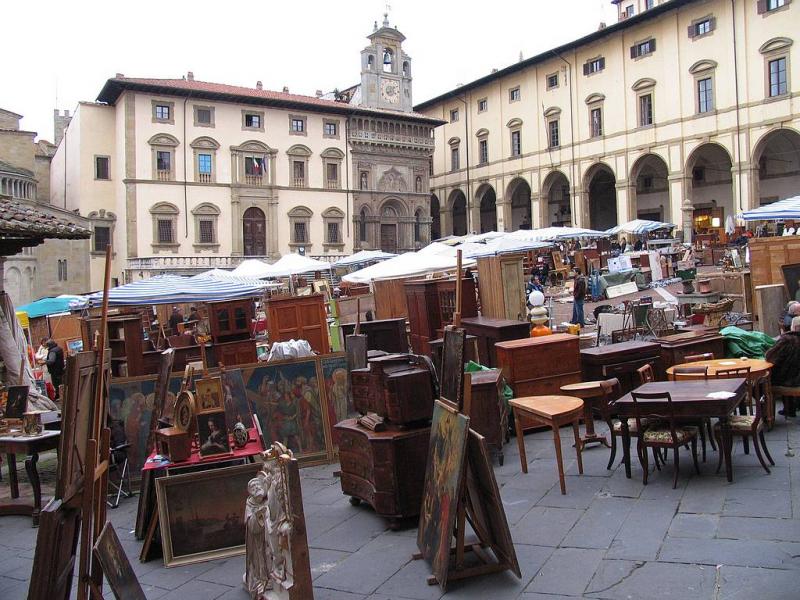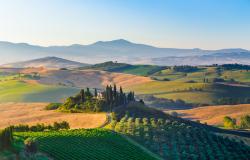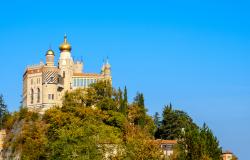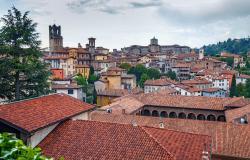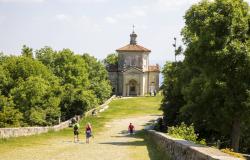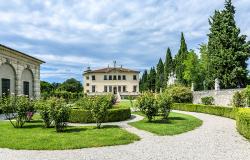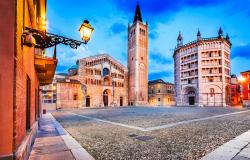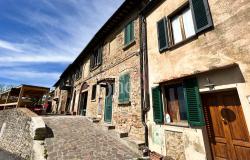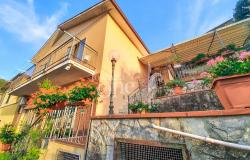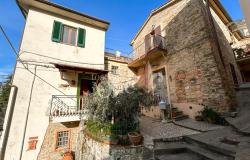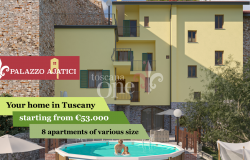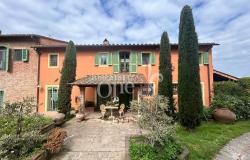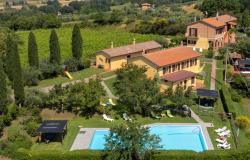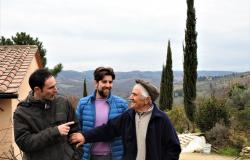Arezzo is often mistakenly overlooked on the tourist trail because its piazza and Palio are second to Siena’s, its art and antiquities are not as grand as Florence or Rome and it doesn’t have the shopping malls of Milan.
However, it has all of these attributes on a smaller scale and is so accessible in a day that you’ll probably want to extend your visit. Arezzo is one of the easiest towns for orientation: streets fan out around a gently sloping hill with the landmark Duomo and a Medici fort at the summit.
Etruscan and Romans
 We start from the bottom of the hill at the station, where buses also arrive and there are a couple of car parks. Turn right past one of two fountains with replicas of the mythical Etruscan Chimera, a lion with a snake and goat growing from its back; along with the prancing horse it’s one of the symbols of Arezzo. Walk past the blocklike bastions of Porta Santo Spirito and turn left at Via Margaritone to the Archaeological Museum, superbly located around the ruins of an elliptical Roman amphitheatre (2nd century AD). The museum is open daily 9-2pm and for 24 you can wander through some of the delights of ancient Arretium, the Roman name for Arezzo.
We start from the bottom of the hill at the station, where buses also arrive and there are a couple of car parks. Turn right past one of two fountains with replicas of the mythical Etruscan Chimera, a lion with a snake and goat growing from its back; along with the prancing horse it’s one of the symbols of Arezzo. Walk past the blocklike bastions of Porta Santo Spirito and turn left at Via Margaritone to the Archaeological Museum, superbly located around the ruins of an elliptical Roman amphitheatre (2nd century AD). The museum is open daily 9-2pm and for 24 you can wander through some of the delights of ancient Arretium, the Roman name for Arezzo.
 Although the labelling could be better, the contents of the display cases are exceptional and the museum is well worth the visit. Upon leaving, walk around the remains of the amphitheatre exiting at Via Francesco Crispi and turn left until you reach Corso Italia, the aorta of Arezzo. To the left is a bland mangle of modern buildings but if you have fashion-conscious teenagers, or you wish to shop for homeware, it’s worth a wander. Otherwise head straight up the hill where exclusive fashion shops line the street and the architecture segues into the more picturesque medieval heart of Arezzo.
Although the labelling could be better, the contents of the display cases are exceptional and the museum is well worth the visit. Upon leaving, walk around the remains of the amphitheatre exiting at Via Francesco Crispi and turn left until you reach Corso Italia, the aorta of Arezzo. To the left is a bland mangle of modern buildings but if you have fashion-conscious teenagers, or you wish to shop for homeware, it’s worth a wander. Otherwise head straight up the hill where exclusive fashion shops line the street and the architecture segues into the more picturesque medieval heart of Arezzo.
A story on the walls
Halfway up the hill a great stop for lunch is the popular Il Saraceno, with its authentic Arezzo cuisine; turn right on Via Mazzini but you may have to book (Tel: +39 0575 27644).
 Across the other side of the Corso, via Cavour opens out into Piazza San Francesco, with the Church of San Francesco, where you will find one of the great masterpieces of the early Renaissance by Piero della Francesca.
Across the other side of the Corso, via Cavour opens out into Piazza San Francesco, with the Church of San Francesco, where you will find one of the great masterpieces of the early Renaissance by Piero della Francesca.
Tickets to view the work are available in a gallery bookshop two doors to the right. The paintings are in the main chapel, behind the altar and large crucifix.
Largely ignored for many years because of heavy damage, the cycle of The Legend of the True Cross has been beautifully restored and is now recognised as the masterpiece that it is.
The apocryphal tale of the sacred wood of the cross includes everyone from Adam to Solomon and Constantine, taking in battles, torture, miracles and the first depiction of night in a painting.
It’s a great saga that finally ends when the cross is finally returned to Jerusalem, which is actually Arezzo. Piero is regarded as an important mathematician who formulated the theories of perspective but I find his greatest achievements are the serene faces of the Queen of Sheba and her ladies in waiting.
Medieval marvels

Back on Corso Italia, another block up the hill brings you to the Romanesque Church of Santa Maria della Pieve, constructed in the 9th and 11th centuries. It has a superb façade with three loggias of slender columns and a campanile of many windows that is known as the ‘tower of a hundred holes’. The unadorned interior has a beautiful medieval bas-relief of the Adoration of the Magi on the inside wall of the façade, and behind the altar in the presbytery, the oldest part of the church, is an exquisite panelled work by the Sienese artist Pietro Lorenzetti (1280-1340). In the crypt are many jewelled relics, and for the morbidly curious, the skull of San Donato and the mortal remains of a Blessed Camaldolite.
 Proceed along the lane at the side of the church and you enter the sloping Piazza Grande, where the Giostra and the Antique Market are held and on any day you will find delightful antique and curiosity shops. Flanking the high side of the Piazza is a splendid Loggia by Giorgio Vasari, native of Arezzo, student of Michelangelo, prolific artist and architect and writer of The Lives of the Artists. (his house can be visited at Via XX Settembre.)
Proceed along the lane at the side of the church and you enter the sloping Piazza Grande, where the Giostra and the Antique Market are held and on any day you will find delightful antique and curiosity shops. Flanking the high side of the Piazza is a splendid Loggia by Giorgio Vasari, native of Arezzo, student of Michelangelo, prolific artist and architect and writer of The Lives of the Artists. (his house can be visited at Via XX Settembre.)
Turn left along the loggia to return to Corso Italia and up past the 13th-century Palazzo Pretorio with its wonderful façade of decaying coats of arms (podesta) of the ruling aretini families. On the corner is Petrarch’s House where the Renaissance intellectual and poet was born in 1304.
Up to the left is the imposing cathedral, landmark of Arezzo, with gothic interior, frescoed ceilings and beautiful stained glass. To the left of a large marble altarpiece containing more relics of San Donato, is another Piero della Francesca fresco, of Mary Magdalene. Finally back to the top of the hill where you are rewarded with a fine view of Tuscany from thehistorical gardens. There are two open-air bars where you can refresh yourself while contemplating the journey back down the hill, discovering the boot makers, leather-workers and jewellery shops that also make Arezzo famous. It is no wonder that Roberto Benigni filmed Life is Beautiful in Arezzo.
Finally back to the top of the hill where you are rewarded with a fine view of Tuscany from thehistorical gardens. There are two open-air bars where you can refresh yourself while contemplating the journey back down the hill, discovering the boot makers, leather-workers and jewellery shops that also make Arezzo famous. It is no wonder that Roberto Benigni filmed Life is Beautiful in Arezzo.
Events not to be missed
 The monthly antique market is held on the first weekend of each month. Arguably the biggest in Italy and possibly the second biggest in Europe visitors will not be disappointed.
The monthly antique market is held on the first weekend of each month. Arguably the biggest in Italy and possibly the second biggest in Europe visitors will not be disappointed.

The Giostra Saraceno, held twice yearly on the second last Saturday of June and the first Sunday of September, includes 300 authentically-dressed medieval militia marching through the town prior to a competition where a horse and rider level a lance at a wooden Saracen. Tickets range in price from 25 standing with the spectators or Tribune seating around 240 but you can watch the procession for free. Tel: +39 0575 377 462
Useful Links
"Arezzo: Illustrated artistic guide" Amazon US.
The "Chimera of Arezzo" on Amazon UK.
Download a printable map of Arezzo.
Interactive map of Arezzo.
